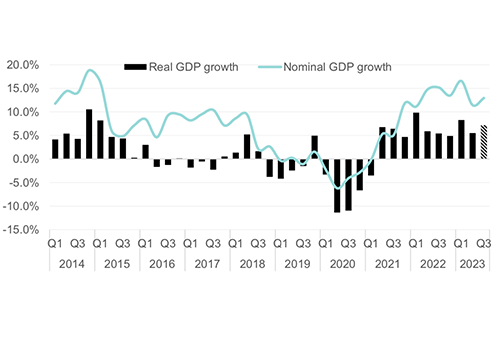The domestic economy expanded the gross domestic product (GDP) by 7.2% during the third quarter (Q3) of 2023, surpassing 5.4% recorded in the corresponding quarter of the previous year.
This is according to the latest GDP figures released by the Namibia Statistics Agency (NSA) last week.
“The economy witnessed a commendable trend, characterized by 10 consecutive quarters of positive growths,” NSA statistician-general Alex Shimuafeni stated.
According to Shimuafeni, in nominal terms, the size of the Namibian economy, quantified by GDP at current prices, reached N$59.7 billion during the quarter under review.
“The commendable performance in Q3 was primarily propelled by the primary industries, which experienced a substantial expansion of 38.3%,” he said.
Notably, domestic economic growth was led by a remarkable 51.7% increase in the mining and quarrying sector and a 19.9% expansion in the agriculture and forestry sectors.
Shimuafeni attributed these positive strides to increased oil and gas exploration activities and heightened momentum in livestock marketing.
He added that tertiary industries saw a growth of 2.2% during the quarter, with key contributions from sectors like wholesale and retail, transport, hotels and restaurants, and financial services, which exhibited substantial expansions in real value added.
Secondary industries faced challenges, encountering contractions of 8.7% in manufacturing and 30.6% in construction during the period.
Commenting on the latest GDP figures, stock brokerage, Simonis Storm (SS) noted that Namibia’s economy displayed resilience during the third quarter, largely due to the strength of primary industries, particularly mining and agriculture.
“However, this reliance on natural resources also leaves the economy vulnerable to external market fluctuations. Secondary industries, such as manufacturing and construction, faced challenges, highlighting the need for economic diversification and strategic infrastructure development,” an SS analysis report reads.
SS emphasised that moving forward, Namibia’s economic success will depend on diversifying economic activities, managing external vulnerabilities, and fostering sustainable growth across all sectors. This approach, the brokerage stated, is vital for building a resilient and balanced economy.
“The Namibian economy continues to demonstrate growth rates not seen in a decade, as indicated by the latest data release revealing a robust economic expansion of 7.2% (an increase of N$2.6 billion from N$36.1 billion in 3Q2022) in the third quarter of 2023. This marks an improvement from the 5.5% growth rate recorded in the 2Q2023 and the 5.4% recorded in the 3Q2022. Notably, this quarter represents the tenth consecutive period of growth since the onset of the pandemic. In nominal terms, the economy also expanded to N$59.7 billion in the third quarter from N$52.9 billion in 3Q2022, reflecting a y/y increase of 12.9%,” SS stated.
Also during Q3 2023, private final consumption expenditure reached N$46.3 billion, marking a N$2.6 billion increase and a real growth of 1.3% compared to the same period last year.
According to SS, government’s final consumption expenditure saw a modest rise of N$300 million but experienced a real-term decline of 0.7%, attributed to reduced spending on employee compensation and goods and services.
“Nonetheless, an increase in government expenditure of approximately N$1.7 billion is anticipated in the next financial year, following the recent announcement of a comprehensive salary and benefits increase for civil servants in Namibia,” SS stated.
The stock brokerage continued that Gross Fixed Capital Formation showed a remarkable increase of 36.3%, driven largely by significant investments in mineral exploration within the mining sector. This substantial growth, SS noted, spurred by initiatives in oil and gas exploration and green hydrogen projects, is indicative of growing investor confidence in these sectors.
Meanwhile, during the third quarter of 2023, the export of goods and services saw an increase of N$2.2 billion, reaching a total of N$22.8 billion. This represents a real growth of 7.4% during the quarter, though it marks a deceleration from the 25.7% increase recorded in the third quarter of 2022. On the import side, there was an 11.2% increase in goods and services, amounting to N$37.1 billion in nominal terms. This reflects a N$5.2 billion increase from the same quarter in the previous year.
“Namibia last recorded a trade surplus in April 2019. The ongoing trade deficit highlights the economic challenges stemming from a persistent trade imbalance, characterised by the nation’s import expenditures substantially exceeding its export revenues. This imbalance exerts a downward pressure on the GDP.
Looking ahead, Namibia’s trade balance is expected to continue showing a deficit, a situation further complicated by the global economic context of subdued demand,” the SS report stated.


